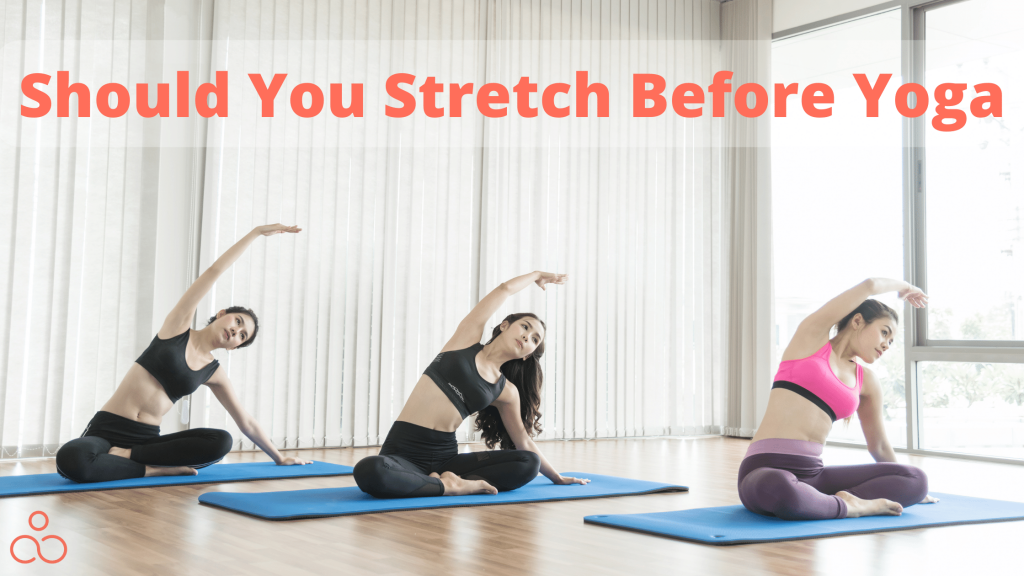Today, Yoga has gained widespread popularity due to its numerous health benefits. Preparatory stretches before any Yoga session play a vital role in ensuring proper alignment, injury prevention, and an overall enjoyable experience. Similar to warming up before any athletic activity, introducing pre-Yoga stretches into your routine can significantly impact your practice. This article will discuss the perks of adding pre-Yoga stretches to your routine, how they can boost your overall health, and finally, furnish you with the ideal Yoga warm-up poses & stretches to integrate into your practice.
So why wait? Let’s get ready on a journey to discover “why should you stretch before Yoga” and “why it is important for overall well-being”.
What is Pre-Yoga Stretching? Why Is It Important For Safe Yoga Practice?
Pre-Yoga stretching is a technique of slowly and gradually increasing the range of motion in the muscles before an intense Yoga session. Pre-Yoga stretching is an important way to prepare your body for Yoga practice.
- It helps warm up the muscles and joints, get the body ready to move and create flexibility, and prevent potential injuries.
- Stretching before Yoga helps the body stay balanced and flexible, allowing for deeper stretches and postures in Yoga practice.
- Helps to warm up the body and increase blood flow to the muscles, which helps the body create heat and prevents straining.
- Provide practitioners the opportunity to learn certain Yoga poses, such as warm-up exercises, to help them better understand the postures.
- Additionally, pre-Yoga stretching can help increase awareness of the body, allowing for better alignment and posture during practice.
Ultimately, regular pre-Yoga stretching will help practitioners maintain their practice and benefit from the many physical and mental benefits of Yoga.
Should You Stretch Before Yoga? The 12 Various Benefits of Pre-Yoga Stretching
The benefits of pre-Yoga stretching have been widely debated among experts. Some people argue that stretching before Yoga can help to improve flexibility, prevent injury, and enhance overall performance. Others, however, claim that stretching before Yoga is unnecessary and can even be counterproductive.
Despite the conflicting opinions, there are some concrete benefits to stretching before Yoga. For one, stretching helps warm up the muscles, leading to increased flexibility and reduced risk of injury. Additionally, stretching can help improve blood flow and circulation to the muscles, enhancing overall performance and recovery.
Now, we will explore some of the top 12 advantages of stretching before Yoga:
- Improved Flexibility: Pre-Yoga stretching can help improve your flexibility and range of motion, which can benefit your overall health and well-being. By stretching before your Yoga practice, you can warm up your muscles and joints and prepare them for future poses. This can help to prevent strain and injury, and it can also help you to deepen your stretches and improve your flexibility over time.
- Warms up your muscles: Pre-Yoga stretching is an effective way to warm up your muscles before you start doing Yoga poses. By doing some basic stretches, you can loosen up stiff areas and improve your posture, thus preventing any possible injuries.
- Enhanced Blood Flow: Stretching before Yoga also helps to increase blood flow to your muscles, supplying them with the oxygen and nutrients necessary to function optimally. Additionally, proper blood flow can help reduce muscle soreness and stiffness after practice.
- Increased Relaxation: Pre-Yoga stretching can also help to promote relaxation and reduce stress. By focusing on your breath and gentle stretches, you can quiet your mind and release tension in your body. This can help to enhance your mood and energy levels, and it can also help you to stay focused and present during your Yoga practice.
- Reduced Risk of Injury: By properly warming up your muscles and joints with pre-Yoga stretching, you can reduce your risk of injury during your Yoga practice. When your muscles are properly warmed up and flexible, they are less likely to strain or suffer from other types of injury. This can help you to keep your practice safe and enjoyable, and it can also help you to continue practicing Yoga regularly over time.
- Helps you focus: Pre-Yoga stretches can help you get the right mindset for your Yoga practice. By focusing on your breath and your body, you can calm your mind and become more present in the moment.
- Reduces muscle soreness: Doing gentle stretches before your Yoga practice can alleviate muscle soreness and stiffness that may be present after your session. Warming up your muscles and enhancing blood flow to your tissues can speed up recovery and make you feel better after your workout.
- Stress Relief: Pre-Yoga stretching can help to relieve stress and tension in your body. As you stretch, you release endorphins that make you feel good and help to reduce anxiety.
- Improved Blood Circulation: Stretching before a Yoga session can significantly enhance your blood circulation. When you elongate your muscles and open your joints, you increase the blood flow to your muscles and organs, which can increase energy levels. This can help improve your overall performance during your Yoga practice and aid in your recovery.
- Increased Body Awareness: You can develop a closer connection with your body and its sensations by incorporating stretching into your routine. This can help you modify and adjust poses, making for a safer and more effective practice.
- Improved Range of Motion: By lengthening and stretching the muscles, pre-Yoga stretching can help increase your range of motion. This can help you achieve deeper poses, improve posture, and move more fluidly throughout your practice.
- Better Performance: Finally, pre-Yoga stretching can help to improve your overall performance. By preparing your body for the physical requirements of Yoga, you’ll be able to achieve your best results and get the most out of your practice.
Ultimately, whether or not you choose to stretch before Yoga is a personal decision. Some people may feel more comfortable getting deeper into poses after stretching, while others may prefer to dive right into their practice without any pre-Yoga preparation. Whatever your approach, listening to your body and doing what feels best for you is important.
How to Stretch Before Yoga? Preparation for Safe Pre-Yoga Stretches
To safely stretch before a Yoga session, it is important to prepare your body properly.
- Do a warm-up for at least 5-10 minutes with light exercises like jumping jacks or walking.
- Once your body feels warm, you can begin your pre-Yoga stretches.
- Start with gentle neck stretches, tilting your head from side to side and bringing your ear towards your shoulder.
- Then, move on to shoulder rolls, gradually increasing the size of the circles you make.
- Next, stretch out your arms and wrists, rotating them in both directions.
- When you are ready to stretch your legs, stand with your feet hip-distance apart and slowly bend forward to touch your toes.
- You can also try lunges, keeping your front knee directly above your ankle and sinking down into your hips.
Remember to listen to your body and only stretch to a comfortable level. With proper preparation and caution, stretching before Yoga can help prevent injury and improve your practice.
Discover 6 Important Types of Pre-Yoga Stretching
Pre-Yoga stretching is an essential component of any Yoga practice. Proper stretching prepares the body for the physical demands of Yoga and helps prevent injury. There are several types of pre-Yoga stretches that can be done to maximize the benefits of your Yoga practice.
- Dynamic Stretches – These types of stretches involve movement and can help increase flexibility and range of motion. Examples of dynamic stretches include arm circles, leg swings, and walking lunges.
- Static Stretches – Static stretches involve holding a stretch for an extended period. These stretches can help enhance your flexibility and alleviate muscle tightness. Examples of static stretches include forward folds, hamstring stretches, and hip openers.
- Foam Rolling – Foam rolling is an excellent technique for giving yourself a massage that can assist in reducing muscle tension and improving flexibility. This method includes applying pressure to different body parts using a foam roller.
- Prop-assisted stretching – This involves using Yoga props such as blocks, straps, and bolsters to help deepen stretches and improve alignment.
- Partner stretching – This involves having a partner assist you in stretching to help increase your range of motion and flexibility. Examples include partner hamstring stretches and assisted chest openers.
- Active Isolated Stretching – This type of stretching involves contracting a muscle and then stretching it to increase flexibility and range of motion.
These are just some examples of pre-Yoga stretches that can be beneficial. Always listen to your body and never push yourself beyond your limits. Consult with a certified Yoga instructor if you have any questions or concerns.
10 Important Yet Beneficial Yoga Poses to Help You Warm Up & Stretch Before Yoga
If you’ve ever arrived early at a Yoga session, you might have noticed your classmates running through simple stretches on their mats. Although most Yoga classes start with a warm-up sequence, doing a few basic poses is a great idea to prepare for the session ahead. This prepares your physical body, sets the tone for your mindset, and allows you to disconnect from the rest of the day.
So, let’s get started! Remember, you don’t need to do the fullest expression of each pose–just gently stretch your body and shake off any stress or tension.
- Cat-Cow Stretch Pose (Marjaryasana + Bitilasana)
Benefits
This simple yet effective pose helps to increase the flexibility and mobility of the spine while also stretching and strengthening the muscles in the torso, arms, and neck.
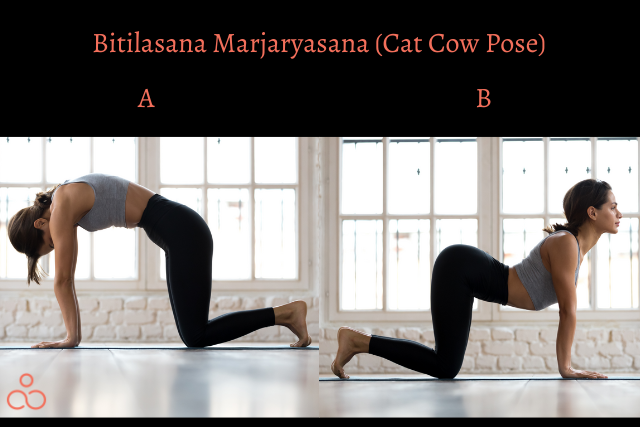
Instructions
Begin by positioning yourself on your hands and knees on the floor. As you inhale, curve your spine and lift both your head and tailbone in the direction of the ceiling while allowing your stomach to drop towards the floor (Cow Pose). Then, as you exhale, round your spine and tuck your chin towards your chest while drawing your tailbone towards your knees (Cat Pose). Repeat this movement several times, coordinating it with your breath.
Benefits
This posture helps to improve circulation, increase energy levels, and relieve stress. It also strengthens the arms, shoulders, and back.
Instructions
Start by positioning yourself on your hands and knees, then lift your hips up and back while straightening your arms and legs. Hold the position for several breaths before releasing.
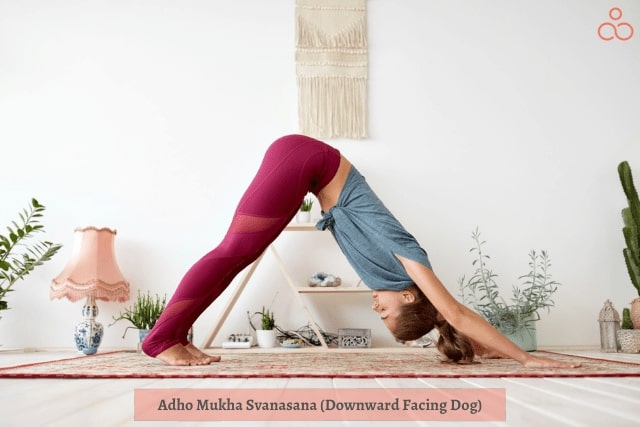
- Extended Triangle Pose (Utthita Trikonasana)
Benefits
This pose helps stretch, strengthens the legs, hips, and spine, and stimulates the digestive and respiratory systems. This pose also helps to improve balance, flexibility, and overall strength in the body.
Instructions
Start by standing tall with your feet slightly wider than hip-width apart. Turn your right foot out and your left foot slightly inwards. Reach your right arm towards your right foot while lifting your left arm up toward the ceiling. Look upwards and hold the position for several breaths, then switch sides and repeat.
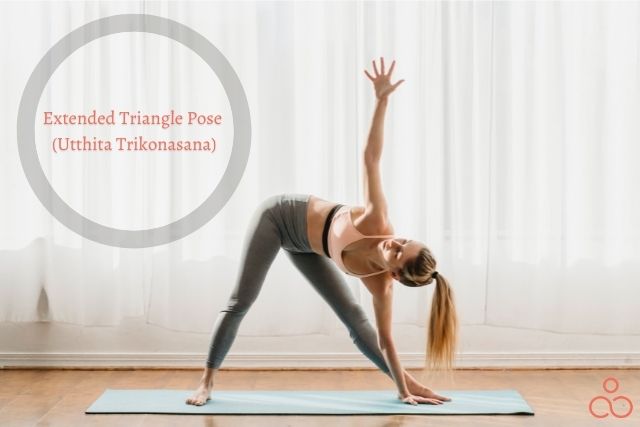
Benefits
This pose helps stretch your chest, lungs, shoulders, and abdomen while strengthening the spine and arms. This pose helps to improve posture and relieve back pain.
Instructions
Begin by lying face down on the floor with your hands flat on the ground under your shoulders. Slowly lift your chest off the ground while keeping your elbows close to your body. Take a deep breath in and hold the pose for a few seconds before exhaling and lowering back to the ground. Repeat as desired.
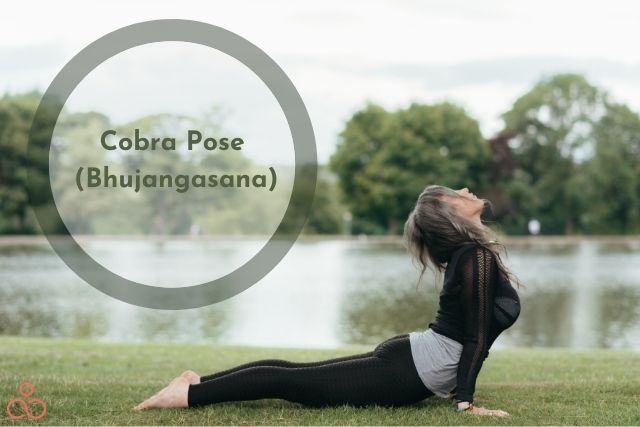
- Garland Pose (Malasana)
Benefits
This posture is an excellent stretch for the hips, thighs, groin, and ankles while promoting flexibility throughout the entire body. This asana also helps with digestion and can be helpful for pregnant women.
Instructions
Begin in a standing position with the feet hip-width apart. Squat down deeply and press the palms together in front of the heart in a prayer position or stretch out forward for balance. Gently press the elbows into the inner thighs to deepen the stretch. Hold the position for several breaths before releasing.
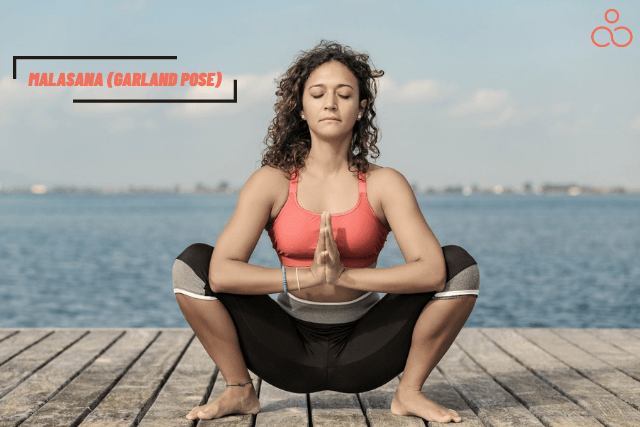
- Two legged forward bend (Paschimottanasana)
Benefits
This pose helps stretch your hamstrings, back muscles, and spine.
Instructions
Sit comfortably on the ground with your legs together and outstretched in front of you. Inhale deeply and lengthen your spine, then exhale and bend forward at your hips, reaching for your toes or ankles. Hold the posture for several deep breaths, then release and return to a seated position.
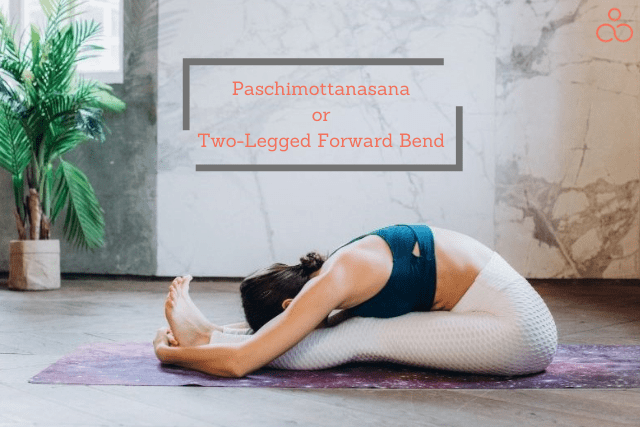
- Child’s Pose (Balasana)
Benefits
This pose helps stretch your spine, hips, thighs, lower back, and ankles while relieving stress and fatigue. It is a gentle resting pose that helps relax and center the mind and body.
Instructions
Begin on your hands and knees, sitting back on your heels with the knees bent and the torso resting on the thighs. Then, stretch your arms out in front of you and your forehead resting on the floor or mat. Hold the pose and breathe deeply for a few minutes to fully relax and release tension in the body. Repeat as desired.
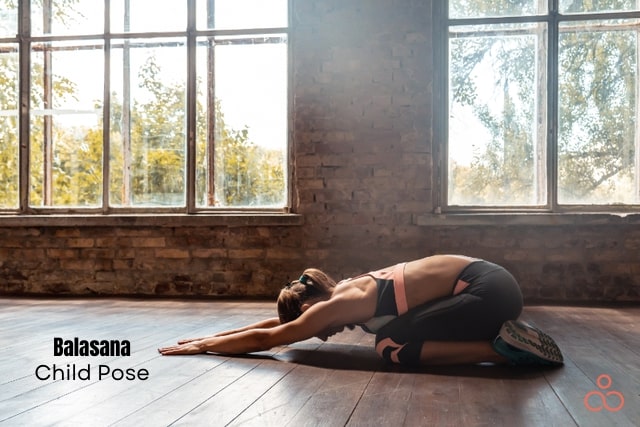
- Warrior II Pose (Virabhadrasana II)
Benefits
This pose helps strengthen your legs and open up your hips.
Instructions
Stand straight and step your feet apart. Turn your right foot outwards and your left foot slightly inwards. Raise your arms to shoulder level, and bend your right knee to a 90-degree angle, keeping your left leg straight. Look out over your right hand and hold the pose for several breaths. Repeat on the opposite side.
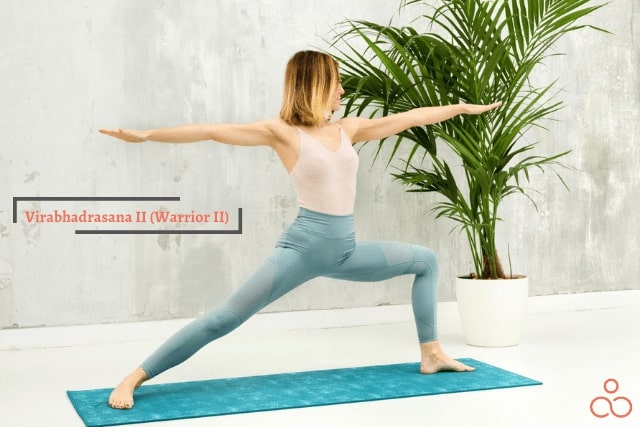
- Bridge Pose (Setu Bandha Sarvangasana)
Benefits
This pose helps stretch your spine and chest while strengthening your glutes and hamstrings.
Instructions
Lie comfortably on your back and bend your knees, placing your feet firmly on the ground. Place your arm on the floor beside your body with palms facing down. Slowly lift your hips from the ground while pressing down with your hands and feet. Hold the position for several breaths and then release by slowly lowering your body back onto the floor.
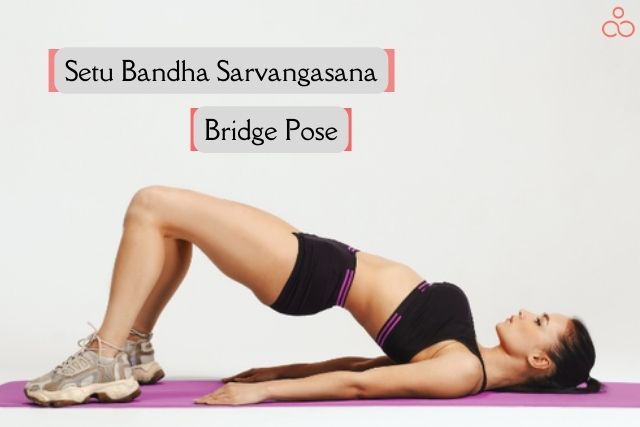
- Tree Pose (Vriksasana)
Benefits
This pose helps improve your balance, stability, and focus.
Instructions
Stand tall with your feet together, transfer your body weight onto your left leg, and place your right foot onto your left thigh with your toes pointing down. Bring your hands together to the heart center in a prayer position at your chest, and hold the pose for several deep breaths. Repeat on the other side.
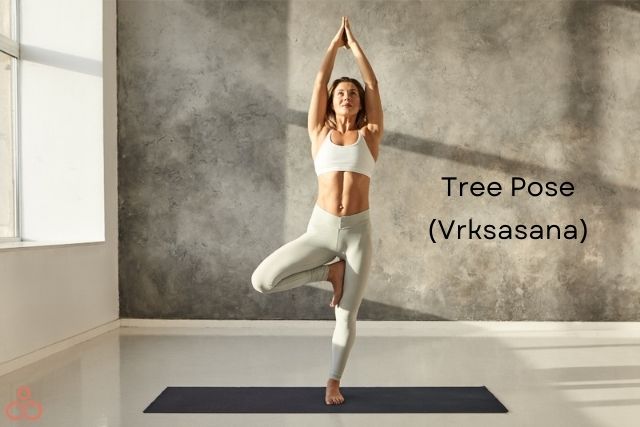
Discover some amazing standing Yoga warm-up poses
Warming up is an important part of any Yoga practice. Standing poses are the perfect way to begin, and the following five poses are the perfect way to get a Yoga routine started.
- Palm tree pose
Start standing with your feet shoulder-width apart. Sweep your arms up overhead, palms facing each other, and gaze up at your thumbs. Take a few full breaths here, feeling the breath and energy flow through your body.
- Swaying palm tree pose
Reach your arms up overhead again, with your palms facing each other. Gently sway from side to side, connecting with your breath. This pose helps to get the body ready for practice.
- Standing wind release pose
From standing, bring your right knee up and hug it. As you take a few deep breaths, try the same with your right knee.
- Standing quad stretch pose
Move into a standing position, and bring your right foot to the back of your mat. Reach down with your right arm, gently guiding your right ankle up, while your left arm reaches up. Repeat on the other side.
- Half forward bend
From standing, bend over and stretch both of your arms out.
3 Bonus seated Yoga warm-up poses
Begin your warming-up sequence by sitting on the floor and extending your legs in front of you with a straight spine. Add some variety to the warm-up by incorporating these seated stretching poses.
- Fire Log Pose
To begin, come into a seated position on the floor and sit cross-legged with your spine tall and shoulders relaxed. Place the left foot on top of the right thigh and keep your knee in line with your ankle. Reach your right arm over and around your left knee and sit tall staying mindful of your breath.
- Cradle Pose Straight Leg
Begin seated on the floor with your legs extended straight in front of you and your spine tall. Place your right ankle on the left thigh. Place your right arm over and around your left leg. If comfortable, take a variation of the pose by bringing your hands to prayer and lifting your arms up towards the sky.
Start in a seated position with one arm crossed over the other. Bend at the elbows and raise your arms up, lightly pressing your palms together and spreading your fingers wide. From there, take a deeper version of the pose by leaning your forehead slightly forward and opening your chest.
Yoga vs. Stretching: Finding the Best Practice for Your Well-Being
Yoga and stretching are both activities that people use to enhance their physical and emotional well-being, but there are significant differences between these techniques. Here, we’ll examine six similarities and differences between Yoga and stretching:
Similarities
- Both activities require a person to use their own body and equipment such as mats, blocks, or straps to strengthen or loosen the muscle tissue.
- They both help people to improve flexibility, and range of motion, tone muscles, and reduce stress.
- Both activities can be tailored to an individual’s ability and size and do not always require gym equipment.
- Both activities can help to increase strength, focus, and balance.
- Individuals across all age groups and fitness levels can participate in any of these exercises.
- Both activities are based on the same basic principles of movement and control.
Differences
| Parameter | Yoga | Stretching |
| Type of Movements | Postures held for a set amount of time. | Dynamic stretches involve alternating passive and active movements. |
| Benefits | Improves strength and flexibility | Improves range of motion |
| Length of Workouts | 45 Minutes to 1 Hour | 15-30 Minutes |
| Intensity Level | Low to moderate intensity | Low-intensity |
| Breathing Techniques | Pranayama | Diaphragmatic breathing |
| Focusing Technique | Meditation | Visualization |
Choosing between Yoga and Stretching Exercises
When considering whether to opt for Yoga or stretching for your workouts, it is important to think about the goal you are trying to achieve. Yoga provides you with strength, vigor, mindfulness, and clarity, making it ideal for an intense workout session. On the other hand, a short stretching routine can improve the efficiency of other forms of exercise. If you opt for Yoga as your choice for exercise, bear in mind the extra time and equipment you may need.
Ultimately, it’s recommended to experiment with a variety of Yoga and stretching techniques to choose the one that is most compatible with your desired fitness and life objectives.
Why & How long should you warm up before doing Yoga?
You’ve likely heard of athletes incorporating Yoga into their warm-up routines before engaging in high-intensity workouts. What you might not have realized is that Yoga can be a challenging workout. So, should you warm up before beginning your Yoga practice? The answer is a resounding yes!
- Before beginning your session, your muscles may be stiff, and neglecting to warm up could put you at risk of injury.
- Take the time to properly warm up your body before jumping into the practice. By doing so, you will increase blood flow and flexibility in your joints, ultimately enhancing the benefits of your practice while decreasing the probability of injury.
- Properly warming up can also allow you to center yourself and connect deeper with your body and breath.
A great way to kick-start your routine is to warm up for 5 to 15 minutes, which will increase your blood pumping and your heart rate gradually. Connecting with your body is crucial, so it’s important to take your time and let your heart rate slowly increase.
The amount of time you will need to warm up will depend on the intensity of your practice and how you feel at that particular moment.
How to Warm Up for Yoga: Dynamic vs Static Stretching and Moderate Exercise Techniques
Yoga is not just a series of simple movements that warm up your body; it’s an ancient practice that strengthens both your mind and body by incorporating stretching, balancing, and breath-to-movement techniques. In addition to strengthening and stretching your muscles, Yoga requires concentration and a mind-body connection, which promotes mindfulness and healthy behaviors in all aspects of your life. To truly reap the benefits of Yoga, your body, and mind must be well-prepared, as Yoga poses push you physically and mentally.
Dynamic vs. Static Stretching
Not all stretching is created equal. While holding a stretch is best for post-workout recovery, gentle movement can be a great way to warm up your muscles and connect with your body.
| Parameter | Dynamic Stretching | Static Stretching |
| Movement | ActiveInvolves moving/stretching through the full range of motion.For example – Movement actions like swaying side to side while you are in a forward bend or peddling your legs in a Downward Dog. | PassiveHolds position for an extended period of time.For example – Holding a pose like a pigeon pose or a seated forward fold. |
| Duration | Shorter | Longer |
| Fitness Routine | The best way to warm up your muscles before a workout. | The best way to stretch your muscles after a workout. |
| Environment | Open environment | Limited space |
Overall, dynamic and static stretching both have their uses and should be used appropriately for each exercise. Dynamic stretching is best for active warm-ups and activities that require high levels of mobility, whereas static stretching is best for pre or post-workout flexibility.
Moderate & Light Exercise
Are you looking to make your Yoga warm-up more effective? Engage your muscles and start your routine with 5-10 minutes of moderate movement and light exercises. Here are three ways to awaken your body and mind before starting your practice:
- Take a walk
This simple, low-intensity exercise is a great way to gradually increase your heart rate and prepare your muscles for your routine.
- Climb stairs
Make your way to your Yoga studio by taking the stairs! This will boost your muscles by pumping blood and oxygen to them before you start.
- Try jumping jacks
Work on coordinating your upper and lower body while increasing your heart rate. Jumping jacks are a great way to connect with your movements and make the most of your Yoga practice.
10 Most Common Mistakes Beginners Should Avoid While Practicing Pre-Yoga Stretch
When practicing Yoga, stretching is a vital component that cannot be ignored. However, many beginners make common mistakes during pre-Yoga stretching that can ultimately lead to injuries or hinder their progress.
- Forgetting to Warm Up
Before starting any Yoga stretch, it is important to warm up the body. This can be done with gentle movements, such as walking or arm circles, to get the blood flowing and the muscles warmed up.
- Holding Stretches Too Long
Stretching can be a great way to release tension in the body. It is important not to hold any stretch for too long. This can cause injury or pain and hinder your progress.
- Not breathing deeply
Breathing is an important part of Yoga and should not be neglected during the pre-Yoga stretch. Slow, deep breathing can help you relax and also help you get deeper into your stretches.
- Pushing Yourself Too Hard
While it is important to challenge yourself during Yoga, pushing yourself too hard during pre-Yoga stretches can cause injury or pain. It is essential to listen to your body and only push yourself as far as you comfortably can.
- Forgetting to Stretch Both Sides
Many beginners forget to stretch both sides of their body, leading to muscle imbalances and hindering progress.
- Using Incorrect Form
Incorrect form during a pre-Yoga stretch can cause injury or pain. It is important to learn proper form from a qualified instructor.
- Comparing Yourself to Others
Yoga is a personal practice, and everyone progresses at their own pace. Comparing oneself to others can lead to a sense of inadequacy or injury.
- Skipping Pre-Yoga Stretch
Pre-Yoga stretch is important for preparing the body for more intensive Yoga practice. Skipping this step can lead to injury or hinder progress.
- Not using props
Props such as blocks and straps can be very helpful in aiding beginners to get into poses correctly. However, many beginners do not use props, which can lead to incorrect alignment and injury.
- Not Listening to Your Body
Listening to your body during a pre-Yoga stretch is important. It is okay to take breaks or modify stretches to accommodate your own abilities.
- Neglecting Post-Stretch Care
After a pre-Yoga stretch, it is important to take care of your body. This includes hydrating, treating sore spots with ice, and getting enough rest.
By avoiding these common mistakes, beginners can make the most out of their pre-Yoga stretch and ultimately progress in their Yoga practice. Always keep in mind to listen to your body and seek guidance from a qualified instructor when needed.
8 Things That You Need To Avoid Doing Before Yoga Practice!
Yoga is a practice that requires focus and discipline. To maximize the benefits of your practice, it is crucial to avoid certain things before you start practicing. Here are eight things to avoid before doing Yoga:
- Eating a heavy meal
Avoid eating a heavy meal for at least 2-3 hours before practicing Yoga. Eating a heavy meal can make you feel bloated and uncomfortable during Yoga.
- Drinking caffeine
Avoid drinking caffeine before Yoga. Caffeine may cause feelings of nervousness and anxiety, potentially disrupting your concentration and presence during Yoga practice.
- Being dehydrated
Dehydration can cause dizziness and fatigue during Yoga practice. It is important to drink enough water before and during the practice.
- Wearing tight or uncomfortable clothing
Wear comfortable and loose clothing that allows you to move freely. Tight or uncomfortable clothing can restrict your movement and make it difficult to get into certain poses.
- Drinking alcohol
Avoid drinking alcohol before Yoga. Alcohol can dehydrate you and make it difficult to focus during Yoga.
- Smoking
Avoid smoking before Yoga. Smoking can make breathing difficult and reduce your lung capacity, making it difficult to get the most out of your Yoga practice.
- Listening to loud or distracting music
Avoid listening to loud or distracting music before Yoga. Focusing on your breath and body can be difficult if you are distracted by external noise.
- Engaging in negative self-talk
Negative self-talk can affect your mental state and prevent you from fully enjoying the practice. It is important to cultivate positive thoughts and intentions.
- Skipping warm-up poses
Skipping warm-up poses can lead to injury and stop you from reaping the full benefits of the practice. It is important to warm up properly before beginning the practice.
- Using electronics
Avoid checking your phone/laptop before Yoga. Using electronics before Yoga practice can disrupt your mental focus and prevent you from being fully present during the practice.
- Arriving late
Arrive at your Yoga practice on time or a few minutes early. Being late can disrupt the flow of the class and make it difficult for you to get into the right mindset for Yoga.
Remember, the goal of Yoga is to find peace and balance within yourself. By avoiding these eight things before your Yoga practice, you can set yourself up for a more peaceful and fulfilling experience.
Important Tips for a Safe and Effective Pre-Yoga Stretching Routine
- Start with some gentle warm-up exercises before attempting any stretches. This will help to prepare your muscles for the work that lies ahead.
- Focus on stretching the muscles you will use during your Yoga practice. For example, if you are doing a lot of forward folds, be sure to stretch your hamstrings and calves.
- Hold each stretch for a minimum of 20 to 30 seconds. This will help to improve your flexibility and range of motion over time.
- Don’t force yourself into any stretch. It is crucial to listen to your body and refrain from pushing beyond your physical boundaries to prevent injury.
- Breathe deeply and evenly throughout your stretching routine. This will help to calm your mind and prepare you for your Yoga practice.
Remember, a good stretching routine is essential for a safe and effective Yoga practice. Take adequate time to properly warm up your body and stretch all your major muscle groups to help prevent injury and improve your performance.
Frequently Asked Questions
Why is stretching necessary before exercise?
Stretching is necessary before exercise because it helps warm up the muscles, increases flexibility, and reduces the risk of injury. By preparing the muscles and joints for physical activity, stretching improves overall performance and aids in allowing the body to move more effectively throughout the workout.
How long should you stretch before Yoga?
It’s recommended to spend 3-5 minutes stretching before any Yoga session or exercise, focusing on key muscle areas to prepare them for the session and increase flexibility.
What stretches should you do before Yoga?
Before beginning Yoga, you should always do some basic stretches to warm up your body. Some of the best stretches to do prior to Yoga include forward folds, hip openers, side stretches, neck stretches, and chest opener stretches. Practicing these will help make your Yoga practice more comfortable and efficient.
Is it bad to stretch cold muscles?
No, it is not recommended to stretch cold muscles. Doing so can increase your chance of injury as your muscles are not warm enough to reduce the risk of muscle strain.
Can you do Yoga without stretching first?
No, it is not advised to practice Yoga without stretching first, as it can put you at risk of injury or discomfort. Stretching is essential to warm up the body before starting Yoga, to increase flexibility, and prevent injuries.
What things should I consider while practicing Yoga at home?
Practicing Yoga at home should be done carefully and with caution. Before beginning, consider these 3 essential things in mind:
- The type of Yoga you are practicing.
- The temperature of the environment.
- How your body is feeling. If not feeling strong enough, consider taking it slow and taking breaks.
Also, be sure to listen to your body, as the safety of your practice is taken precedence over progressing to the more difficult poses.
Conclusion
Yoga is much more than just a set of simple stretches. Achieving the right physical and mental states beforehand is important to engage in the practice fully. It’s not always necessary to generate heat through movement in order to warm up muscles and restore elasticity and mobility. If you feel limber and fresh, you don’t need to push too hard through a dedicated warm-up. However, if you feel cold or resistant, it’s important to address that before beginning your practice.
Ultimately, there’s no harm in starting with some light movements to get warmed up. You can elevate and enhance your Yoga practice by following the tips mentioned above.

